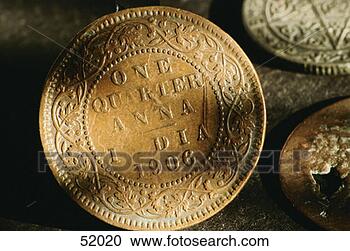History of indian coin

India won its independence on 15 th August, 1947. During the period of
transition India retained the monetary system and the currency and
coinage of the earlier period. While Pakistan introduced a new series
of coins in 1948 and notes in 1949, India brought out its distinctive
coins on 15 th August, 1950.
Chronologically, the main considerations influencing the coinage
policy of Republic India over time have been:
The incorporation of symbols of sovereignty and indigenous motifs on
independence;
Coinage Reforms with the introduction of the metric system;
The need felt from time to time to obviate the possibility of the
metallic value of coins rising beyond the face value;
The cost-benefit of coinisation of currency notes
Independent India Issues could broadly be categorised as

The Frozen Series 1947-1950 :
This represented the currency arrangements during the transition
period upto the establishment of the Indian Republic. The Monetary
System remained unchanged at One Rupee consisting of 192 pies..
1 Rupee = 16 Annas
1 Anna = 4 Pice
1 Pice = 3 Pies
The Anna Series :
This series was introduced on 15th August, 1950 and represented the
first coinage of Republic India. The King's Portrait was replaced by
the Lion Capital of the Ashoka Pillar. A corn sheaf replaced the Tiger
on the one Rupee coin. In some ways this symbolised a shift in focus
to progress and prosperity. Indian motifs were incorporated on other
coins. The monetary system was largely retained unchanged with one
Rupee consisting of 16 Annas.
Nomination
Metal
Obverse
Reverse
Rupee One
Nickel
Half Rupee
Nickel
Quarter Rupee
Nickel
Two Anna
Cupro-Nickel
One Anna
Cupro-Nickel
Half Anna
Cupro-Nickel
One Pice
Bronze
â

The Decimal Series :
The move towards decimalisation was afoot for over a century. However,
it was in September, 1955 that the Indian Coinage Act was amended for
the country to adopt a metric system for coinage. The Act came into
force with effect from 1 st April, 1957. The rupee remained unchanged
in value and nomenclature. It, however, was now divided into 100
'Paisa' instead of 16 Annas or 64 Pice. For public recognition, the
new decimal Paisa was termed 'Naya Paisa' till 1 st June, 1964 when
the term 'Naya' was dropped.
Naya Paisa Series 1957-1964 :
Enomination
Metal
Weight
Shape
Size
Coin
Rupee One
Nickel
10 gms
Circular
28 mm
Fifty Naye Paise
Nickel
5 gms
Circular
24 mm
Twenty Five Naye Paise
Nickel
2.5 gms
Circular
19 mm
Ten Naye Paise
Cupro-Nickel
5 gms
Eight Scalloped
23 mm (across scallops)
Five Naye Paise
Cupro-Nickel
4 gms
Square
22 mm (across corners)
Two Naye Paise
Cupro-Nickel
3 gms
Eight Scalloped
18 mm (across scallops)
One Naya Paisa
Bronze
1.5 gms
Circular
16 mm
With commodity prices rising in the sixties, small denomination coins
which were made of bronze, nickel-brass, cupro-nickel, and
Aluminium-Bronze were gradually minted in Aluminium. This change
commenced with the introduction of the new hexagonal 3 paise coin. A
twenty paise coin was introduced in 1968 but did not gain much
popularity.
Aluminium Series 1964 onwards :
Enomination
Metal
Weight
Shape
Size
Coin
One Paisa
Aluminium-Magnesium
0.75 gms
Square
17 mm (Daigonal)
Two Paise
Aluminium-Magnesium
1 gm
Scalloped
20 mm (across scallops)
Three Paise
Aluminium-Magnesium
1.25 gms
Hexagonal
21 mm (Diagonal)
Five Paise
Aluminium-Magnesium
1.5 gms
Square
22 mm (Diagonal)
Ten Paise
Aluminium-Magnesium
2.3 gms
Scalloped
26 mm (across scallops)
Twenty Paise
Aluminium-Magnesium
2.2 gms
Hexagonal
26 mm (diagonal)
24.5 mm (across flats)
Over a period of time, cost benefit considerations led to the gradual
discontinuance of 1, 2 and 3 paise coins in the seventies; Stainless
steel coinage of 10, 25 and 50 paise, was introduced in 1988 and of
one rupee in 1992. The very considerable costs of managing note issues
of Re 1, Rs 2, and Rs 5 led to the gradual coinisation of these
denominations in the 1990s.
Contemporary Coins :
Enomination
Metal
Weight
Diameter
Shape
Cupro-Nickel
9..00 gms
23 mm
Circular
Cupro-Nickel
6..00 gms
26 mm
Eleven Sided
Ferratic Stainless Steel
4..85 gms
25 mm
Circular
Ferratic Stainless Steel
3..79 gms
22 mm
Circular
Ferratic Stainless Steel
2..83 gms
19 mm
Circular
Ferratic Stainless Steel
2..00 gms
16 mm
Circular
|
|
